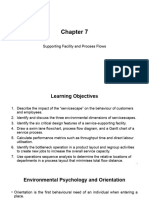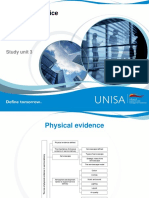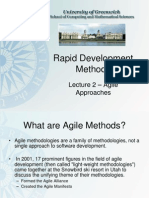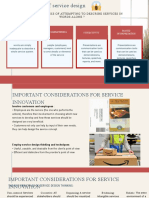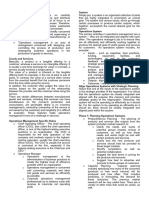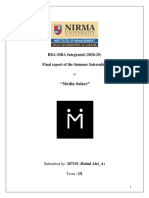0 ratings0% found this document useful (0 votes)
5 viewsOm Midterms
Om Midterms
Uploaded by
belenjenn004Copyright:
© All Rights Reserved
Available Formats
Download as PDF, TXT or read online from Scribd
Om Midterms
Om Midterms
Uploaded by
belenjenn0040 ratings0% found this document useful (0 votes)
5 views4 pagesOriginal Title
OM–MIDTERMS
Copyright
© © All Rights Reserved
Available Formats
PDF, TXT or read online from Scribd
Share this document
Did you find this document useful?
Is this content inappropriate?
Copyright:
© All Rights Reserved
Available Formats
Download as PDF, TXT or read online from Scribd
Download as pdf or txt
0 ratings0% found this document useful (0 votes)
5 views4 pagesOm Midterms
Om Midterms
Uploaded by
belenjenn004Copyright:
© All Rights Reserved
Available Formats
Download as PDF, TXT or read online from Scribd
Download as pdf or txt
You are on page 1of 4
SERVICE DESIGN performed by either the employee,
user, or customer, throughout the
What is Service Design? service (ex: enrolment procedure)
3. Props - Refers to the physical or
● The activity of planning and digital artifacts including products
organizing a business’s resources that are needed to perform the
(people, props, and processes) in service successfully. (e.g. physical
order to space, digital environment:
○ (1) directly improve the website, socmed pages, and
employee’s experience, objects like digital files and
and physical products)
○ (2) indirectly, the
customer’s experience. Service Design Blueprint
Two Parts of Service Design
Components
1. Frontstage Components include:
● Channels
● Products
● Touchpoints
● Interfaces
2. Backstage Components include:
● Policies
● Technology
● Infrastractures
● Systems
Principles of Service Design
Objective of Service Design
● The objective of service design is 1. Human-centered - consider the
to formulate both frontstage and experience of all the people
backstage strategies that meet the affected by the service.
customers’ needs in the most 2. Collaborative - stakeholders of
relevant way whilst remaining various backgrounds and functions
economic (or sustainable) for the should be actively engaged in the
service provider. Ideal services are service design process.
considered to be user-friendly and 3. Iterative - service design is an
competitive within their market. exploratory, adaptive, and
experimental approach, iterating
Components of Service Design toward implementation.
Three main components of Service Design 4. Sequential - the service should be
1. People - They are the individuals visualized and orchestrated as a
who may be directly affected by sequence of interrelated actions.
the service. This component 5. Tangible and Sustainable - a
includes anyone who creates and project needs to include
uses the service. (may include fundamental research, co-creation
fellow customers that you will and prototyping to evidence actual
encounter throughout the service business value.
as well as your partners) (e.g. 6. Holistic - services grounded
employees, customers, partners) through stakeholders with different
2. Processess - It is any workflows, backgrounds and perspectives,
rituals, procedures, that are being that ultimately meet their needs.
Benefits of Service Design ● This is a wider category of objects
that serve multiple purposes within
1. Surfacing Conflicts the service environment.
2. Fostering hard conversations ● Signage can dictate directions or
3. Reducing redundancies with a instructions, or simply
bird’s eye view communicate a brand name.
4. Forming relationships. Logos, artifacts, and color are
included in this category.
THE SERVICESCAPE
Aspects of Servicescape: Ambient
What is servicescape? Conditions
● “The environment in which the ● This refers to a number of often
service is assembled and in which tangible elements in a service
the seller and customer interact, environment including sound or
combined with tangible noise, temperature, light, music,
commodities that facilitate odor or smell, and even air quality.
performance or communication of
the service.” (Booms & Bitner, Elements of Servicescape
1981) ● Facility Exterior
● “Demonstrates the relationship ○ Landscape
between the physical ambience ○ Exterior design
and place and its impact on service ○ Surrounding environment
delivery and perception.” ○ Parking
● Servicescapes are uniquely ○ Signage
designed by each business to ● Facility interior
create an atmosphere that aims to ○ Music
enhance their customer’s ○ Layout
experiences, and ultimately have ○ Equipment
an impact on their behavior. ○ Air quality temperature
○ Interior design
Aspects of Servicescape: Spatial ● Others
Layout and Functionality ○ Virtual servicescape
● Space and function refers to the ○ Brochures
spatial layout of a service ○ Employee dress
environment, how easy or difficult it ○ Billing statement
is to navigate, and how functional it ○ Web pages
is. (The type of furniture and ○ Uniforms
equipment used in the space also ○ Reports
play a part in building the ○ Stationary
servicescape space.) ○ Business cards
● It is about the way you arrange the
furnishings, equipment and Roles of Servicescape
machinery, their shape and size ● Facilitator - act as a facilitator to
and of course, the spatial help people in their surroundings
relationship which exists among ● Package - helps to convey the
them. internal image through its outward
● Functionality is about the ability of appearance
the items to accomplish customer ● Socialiser - act as a perfect
satisfaction. socializer between both customers
and employees
● Differentiator - act as a
Aspects of Servicescape: Signs, differentiator by separating designs
Symbols, and Artifacts of a company from its competitor
Types of Servicescape Environment:
Lean Servicescape
● Designing this type of environment organization. It involves analyzing
is straightforward and includes the performance of the services,
fewer interactions, elements, and identifying opportunities for
spaces between employees and improvement, and making
customers. decisions about which services to
provide, how to package them, and
Types of Servicescape Environment: how to price them.
Elaborate Servicescape
The process of service portfolio
● Designing this type of management typically involves the
servicescape requires teams that following steps:
are skilled in their work and are
fully aware of the corporate vision ● Service definition
and desired outcome. This ● Service Analysis
includes multiple spaces, ● Service Strategy
elements, and interactions
between employees and ● Service Design
customers. ● Service Transition
● Service Operation
Functions of Servicescape:
● Image, differentiation, and
Demand Management
positioning
● Demand management in a service
● Facilitating service encounter and
business involves a company’s
increasing productivity
processes and strategies to
balance supply and demand for its
services. It is essential because it
SERVICE STRATEGY
helps companies ensure they have
enough resources to meet
What is a Service Strategy
customer demand while minimizing
● A service strategy is a key aspect the costs associated with
of service management that overproduction or underproduction
focuses on developing and
implementing strategies to deliver Key Strategies that Service Businesses
effective and efficient services that can use to Manage Demand:
align with an organization’s overall
● Forecasting
business objectives. It involves
● Pricing
identifying the services that an
● Capacity management
organization should offer,
● Promotions and marketing
determining the target market for
● Service differentiation
these services, and developing a
plan to deliver them.
Financial Management
Types of Service Strategy
● Financial management is crucial
1. Service Portfolio Management for any type of business, including
2. Demand Managament service businesses. Service
3. Financial Management businesses provide intangible
4. Business Relationship goods or services to their
Management customers, and their success is
5. Service Level Management primarily determined by their ability
to satisfy their customers’ needs
Service Portfolio Management and expectations. Financial
management in a service business
● Service portfolio management is involves managing the financial
the process of managing a resources of the business in a way
collection of services offered by an
that helps it achieve its goals and 1. Service level agreement (SLA)
objectives. negotiation and definition involves
agreeing on the scope of services
Key aspects of Financial Management to be provided, the performance
in a Service Business: levels that will be delivered, and
the metrics that will be used to
● Revenue Management measure performance.
● Cost Management 2. Service level monitoring involves
● Budgeting monitoring service performance
● Cash Flow Management against the agreed-upon SLAs and
● Financial Analysis and Reporting identifying any areas of
non-compliance.
Business Relationship Management 3. Service level reporting involves
producing regular reports on
● Business Relationship service performance to
Management (BRM) is a strategic stakeholders, including customers
and collaborative approach to and senior management.
managing and improving the 4. Service level review involves
relationships between a business regularly reviewing service
and its customers, partners, and performance against the SLAs and
suppliers. BRM aims to establish identifying opportunities for
and maintain mutually beneficial improvement.
relationships that can help achieve 5. Service level improvement involves
the business’s objectives. improving service performance to
ensure that SLAs are met or
BRM involves several key activities: exceeded
● Understanding the needs and Service Strategy Examples
goals of the different stakeholders,
suppliers, and customers ● Personalization (ex: Netflix)
● Building and maintaining ● Self-service (ex: self-check-out
relationships kiosk)
● Facilitating communication ● 24/7 Support (ex: chatbots, call
● Identifying opportunities center, and customer service
● Managing risk hotlines)
● Transparency (ex: providing pricing
Service Level Management info to customers
● Proactive support (ex: identifying
● Service level management (SLM) potential issues before the risks
is a process within IT service occur)
management (ITSM) that is
responsible for setting, monitoring,
and improving the level of service
that IT delivers to its customers.
SLM is concerned with defining
and agreeing upon service level
agreements (SLAs) with customers
and then monitoring and reporting
on performance against those
SLAs.
The SLM Process typically includes the
following steps:
You might also like
- Introduction To Personnel ManagementDocument16 pagesIntroduction To Personnel Managementmitiha5909No ratings yet
- Om Midterms 1Document5 pagesOm Midterms 1belenjenn004No ratings yet
- Servicescape: Prepared By:-Sandeep Kumar Mba 2 YearDocument11 pagesServicescape: Prepared By:-Sandeep Kumar Mba 2 YearSandeep SinghNo ratings yet
- Servicescape: by Vijyata Assistant Professor, Dept. of Management Ranchi Women'S College Ranchi UniversityDocument20 pagesServicescape: by Vijyata Assistant Professor, Dept. of Management Ranchi Women'S College Ranchi UniversityVijyata SinghNo ratings yet
- Servicescape in Service MarketingDocument20 pagesServicescape in Service MarketingVijyata SinghNo ratings yet
- Opeman130 - Chapter 5 Midterm ReviewerDocument5 pagesOpeman130 - Chapter 5 Midterm Reviewerijustwannasay sayyouareworthyNo ratings yet
- Unit 3 Services Marketing PPT MBA IV SemDocument32 pagesUnit 3 Services Marketing PPT MBA IV SemMagatapalli Venkata Venu Gopal- GitamNo ratings yet
- Astin Service Design ReportDocument9 pagesAstin Service Design Reportastin.kishanNo ratings yet
- Workspace GuidelinesDocument60 pagesWorkspace GuidelinesGc45No ratings yet
- MORITZ Service Design Practical Access To An Evolving Field PDFDocument271 pagesMORITZ Service Design Practical Access To An Evolving Field PDFBruno AndréNo ratings yet
- 5.aligning Service Design & StandardsDocument14 pages5.aligning Service Design & StandardsNeha RajputNo ratings yet
- 6-7. Aligning Service Design and StandardsDocument23 pages6-7. Aligning Service Design and StandardsIrfan Ahmed Sakib100% (1)
- Managing The Customer InterfaceDocument36 pagesManaging The Customer InterfaceSREEVISAKH V SNo ratings yet
- Service Management - Chapter 7Document10 pagesService Management - Chapter 7ashkanfashamiNo ratings yet
- THC 5 Chapter 6Document17 pagesTHC 5 Chapter 6Nicole RaborNo ratings yet
- Physical Evidence and The ServicescapeDocument11 pagesPhysical Evidence and The ServicescapeSilvia SimorangkirNo ratings yet
- Om NicaDocument41 pagesOm NicaZyribelle Anne JAPSONNo ratings yet
- Lecture 5 - Service Design SVDocument21 pagesLecture 5 - Service Design SVTrần Khánh HoàngNo ratings yet
- Service Marketing 5 - (People, Process, Physical Evidence and Servicescape)Document56 pagesService Marketing 5 - (People, Process, Physical Evidence and Servicescape)Soumya Jyoti Bhattacharya50% (2)
- Module 6 - Physical Evidence in ServicesDocument54 pagesModule 6 - Physical Evidence in Servicesvinish21No ratings yet
- Chapter 5 - OpemanDocument4 pagesChapter 5 - OpemanAngelgraceregaladoNo ratings yet
- Lesson 5Document20 pagesLesson 5francine.bughao03No ratings yet
- Reviewer in Operation ManagementDocument3 pagesReviewer in Operation ManagementAngeline Merez DimeNo ratings yet
- OM CH 5 7Document7 pagesOM CH 5 7Rayno Chiu CimafrancaNo ratings yet
- Ramya Nomula: Career ObjectiveDocument3 pagesRamya Nomula: Career Objectiveramyanomula99No ratings yet
- BME Chap 4Document60 pagesBME Chap 4eggusiloguNo ratings yet
- Chap 4Document58 pagesChap 4konnichiwa2210No ratings yet
- L1 COMP1649 IntroductionDocument41 pagesL1 COMP1649 IntroductionColnem BeatsNo ratings yet
- G6 QSMDocument43 pagesG6 QSMmaalihanlei2006No ratings yet
- 1.SERVICE DESIGN LectureDocument39 pages1.SERVICE DESIGN LectureMikee RizonNo ratings yet
- KSSP 2kolDocument174 pagesKSSP 2kolDominik JosipovicNo ratings yet
- THC 212-C6Document8 pagesTHC 212-C6Alyzza CasNo ratings yet
- MNM1502 Study Unit 3Document23 pagesMNM1502 Study Unit 3Kirthi SinghNo ratings yet
- Chap08 (MGMT225)Document25 pagesChap08 (MGMT225)Nurul AinisNo ratings yet
- New Service Design: Presented by Group 3 Jaseer - Jafar Avinash.T.A Jaseena.JDocument24 pagesNew Service Design: Presented by Group 3 Jaseer - Jafar Avinash.T.A Jaseena.JJaseena JayarousNo ratings yet
- C It Dev Ops Template Week 4 DraftDocument8 pagesC It Dev Ops Template Week 4 DraftUrim UwanaNo ratings yet
- Group 6 Designing and Managing ServicesDocument22 pagesGroup 6 Designing and Managing ServicesRoy CabarlesNo ratings yet
- Annex 1 (A) Target Operating Model: The Compelling AlternativeDocument8 pagesAnnex 1 (A) Target Operating Model: The Compelling AlternativeMohammad OthmanNo ratings yet
- Chapter 6 QSMDocument63 pagesChapter 6 QSMChristian CandareNo ratings yet
- 2 RDM Agile ApproachesDocument22 pages2 RDM Agile ApproachesWilliam NtejaNo ratings yet
- Operations Management Week 3 - Process Design and Analysis-StudentDocument42 pagesOperations Management Week 3 - Process Design and Analysis-StudentshashikantppediaNo ratings yet
- 01 Introduction To ITILDocument22 pages01 Introduction To ITILIchwan HabibieNo ratings yet
- Service Blueprints - Communicating The Design of Services - Interaction Design FoundationDocument7 pagesService Blueprints - Communicating The Design of Services - Interaction Design FoundationDiego MorenoNo ratings yet
- Service Design - Module3Document13 pagesService Design - Module3satya geethNo ratings yet
- Module VIDocument7 pagesModule VIBunty GhoshNo ratings yet
- Is 07701 Lect-5Document19 pagesIs 07701 Lect-5zuhuraNo ratings yet
- Service Marketing Assingnment: MADE BY-PRAGUN VIJ-35621201718 PRANAY CHADHA-35721201718Document16 pagesService Marketing Assingnment: MADE BY-PRAGUN VIJ-35621201718 PRANAY CHADHA-35721201718Melodyo ZoneNo ratings yet
- SMKT-Class 3-2022Document29 pagesSMKT-Class 3-2022Carlos EspinoNo ratings yet
- ITILDocument43 pagesITILIbtisam AbNo ratings yet
- 0002 - OM SESSION 2 (Chapter 4 - Process Design & Chapter 5 - Innovation & Design in Services & Products)Document49 pages0002 - OM SESSION 2 (Chapter 4 - Process Design & Chapter 5 - Innovation & Design in Services & Products)Tú Anh NguyễnNo ratings yet
- 1 - ECEG-7525 - Course OverviewDocument26 pages1 - ECEG-7525 - Course OverviewsamuelNo ratings yet
- Chapter-2 Project Organization StructureDocument20 pagesChapter-2 Project Organization Structuresiraj kataleNo ratings yet
- QSM Midterm Handout StudentDocument13 pagesQSM Midterm Handout StudentArkin SalvadorNo ratings yet
- Challenges of Service Design: What Are The Risks of Attempting To Describe Services in Words Alone ?Document10 pagesChallenges of Service Design: What Are The Risks of Attempting To Describe Services in Words Alone ?LinhThùyNo ratings yet
- Design of Services1Document33 pagesDesign of Services1Prakash WarrierNo ratings yet
- Conceptual Design Framework For Ict Service System Development and DeliveryDocument10 pagesConceptual Design Framework For Ict Service System Development and DeliveryAbhijeet KumarNo ratings yet
- Chap 5 - Service Design - SVDocument19 pagesChap 5 - Service Design - SVThy NguyenNo ratings yet
- Service Design and Service Delivery ProcessDocument14 pagesService Design and Service Delivery ProcessEric PottsNo ratings yet
- Design and Managing Service 1Document9 pagesDesign and Managing Service 1rioverosanniejoyNo ratings yet
- Operations MNGT L2Document4 pagesOperations MNGT L2Mikey DealoNo ratings yet
- Digital Workplace Strategy & Design: A step-by-step guide to an empowering employee experienceFrom EverandDigital Workplace Strategy & Design: A step-by-step guide to an empowering employee experienceNo ratings yet
- Threadless CaseDocument3 pagesThreadless CaseBasile ParovelNo ratings yet
- Contemporary Applications of Marketing IntelligenceDocument16 pagesContemporary Applications of Marketing Intelligencesunil_birmanNo ratings yet
- INTRODUCTIONDocument3 pagesINTRODUCTIONShaina Jean PiezonNo ratings yet
- Trends in Management Accounting in The Asian Pacific RegionDocument7 pagesTrends in Management Accounting in The Asian Pacific Regionhaitex48No ratings yet
- RiskMetrics (Techinical Document) PDFDocument52 pagesRiskMetrics (Techinical Document) PDFAngel Gutiérrez ChambiNo ratings yet
- SBD Pricing Assignment - 30.10.2022Document2 pagesSBD Pricing Assignment - 30.10.2022ratnesh gautamNo ratings yet
- Marketing Communication ManagementDocument2 pagesMarketing Communication ManagementRithesh KNo ratings yet
- November 2022 62501/CZ21A/AY21A/BS21A: 4. That Do You Mean B - 4x'erage Clause Police ?Document9 pagesNovember 2022 62501/CZ21A/AY21A/BS21A: 4. That Do You Mean B - 4x'erage Clause Police ?KavithaNo ratings yet
- Management Advisory Services-Elimination RoundDocument18 pagesManagement Advisory Services-Elimination RoundRyan Christian M. Coral0% (1)
- Metrobank Home Loan Application Form For IndividualsDocument3 pagesMetrobank Home Loan Application Form For IndividualsRaffy VelezNo ratings yet
- A Project Report On The Implementation of The Presell System in Chandigarh - Its Pros and ConsDocument8 pagesA Project Report On The Implementation of The Presell System in Chandigarh - Its Pros and Conswinner5555No ratings yet
- Starbooks Café: Market PlanDocument15 pagesStarbooks Café: Market PlanVanNo ratings yet
- An Application of The Balanced Scorecard in RetailingDocument27 pagesAn Application of The Balanced Scorecard in RetailingYoga Adhi Prabowo100% (1)
- Naukri KumarPotdar 2498365 - 04 05 - 1Document1 pageNaukri KumarPotdar 2498365 - 04 05 - 1Tanya MehtaNo ratings yet
- Rahul Airi - Prof. Bhajan Lal - Final ReportDocument36 pagesRahul Airi - Prof. Bhajan Lal - Final ReportRahul AiriNo ratings yet
- Chapter 10Document5 pagesChapter 10Ailene QuintoNo ratings yet
- MUH119 Week1 NotlarDocument46 pagesMUH119 Week1 NotlarSelen AslanNo ratings yet
- Unit 2 - Business PlanDocument6 pagesUnit 2 - Business PlanAnne RaveloNo ratings yet
- Prajkta BBA Marketing ProjectDocument29 pagesPrajkta BBA Marketing ProjectPratik BhujbalNo ratings yet
- A - 2 Ch01 Financial Audit ComponentsDocument15 pagesA - 2 Ch01 Financial Audit ComponentsBlacky PinkyNo ratings yet
- BHAGALAXMDocument94 pagesBHAGALAXMsoumavabose84No ratings yet
- CV - Okechukwu A MbachuDocument2 pagesCV - Okechukwu A MbachuOKECHUKWU MBACHUNo ratings yet
- Eemium and Subscription Business Model Section 3Document38 pagesEemium and Subscription Business Model Section 3sasobaidNo ratings yet
- 6.SWOT Analysis-Industry Background-Competitors AnalysisDocument16 pages6.SWOT Analysis-Industry Background-Competitors AnalysisACBNo ratings yet
- 12 PB2 Entrepreneurship 2022Document10 pages12 PB2 Entrepreneurship 2022CA Ankit PatelNo ratings yet
- Bam 040 ReviewerDocument7 pagesBam 040 ReviewerAndrea Vila VelascoNo ratings yet
- INTRODUCTIONDocument54 pagesINTRODUCTIONnayhachivaareeNo ratings yet
- Financial Planning and BudgetingDocument45 pagesFinancial Planning and BudgetingRafael BensigNo ratings yet
- Igate Patni Lab-Jan 03 2012Document30 pagesIgate Patni Lab-Jan 03 2012m_lohaniNo ratings yet













